Infection and Control Assignment - HLTWHS002, Nursing, Semester 1
VerifiedAdded on 2021/04/16
|17
|5291
|548
Homework Assignment
AI Summary
This assignment addresses infection and control practices in healthcare settings, covering topics such as modes of transmission, immunity, respiratory etiquette, wound infections, hand hygiene, PPE, and outbreak management. The student answers questions related to workplace scenarios, including dealing with an unwell colleague, caring for a post-caesarean patient, managing a norovirus outbreak in an aged care facility, and responding to a workplace incident involving a urine splash. The assignment also explores the differences between colonization, infection, and disease, the nature of viruses and fungi, and relevant WHS legislation and principles. The student demonstrates knowledge of infection control protocols, including PPE removal, cleaning procedures, and reporting obligations. The assignment includes in-text referencing and a reference list using APA 6th edition style.
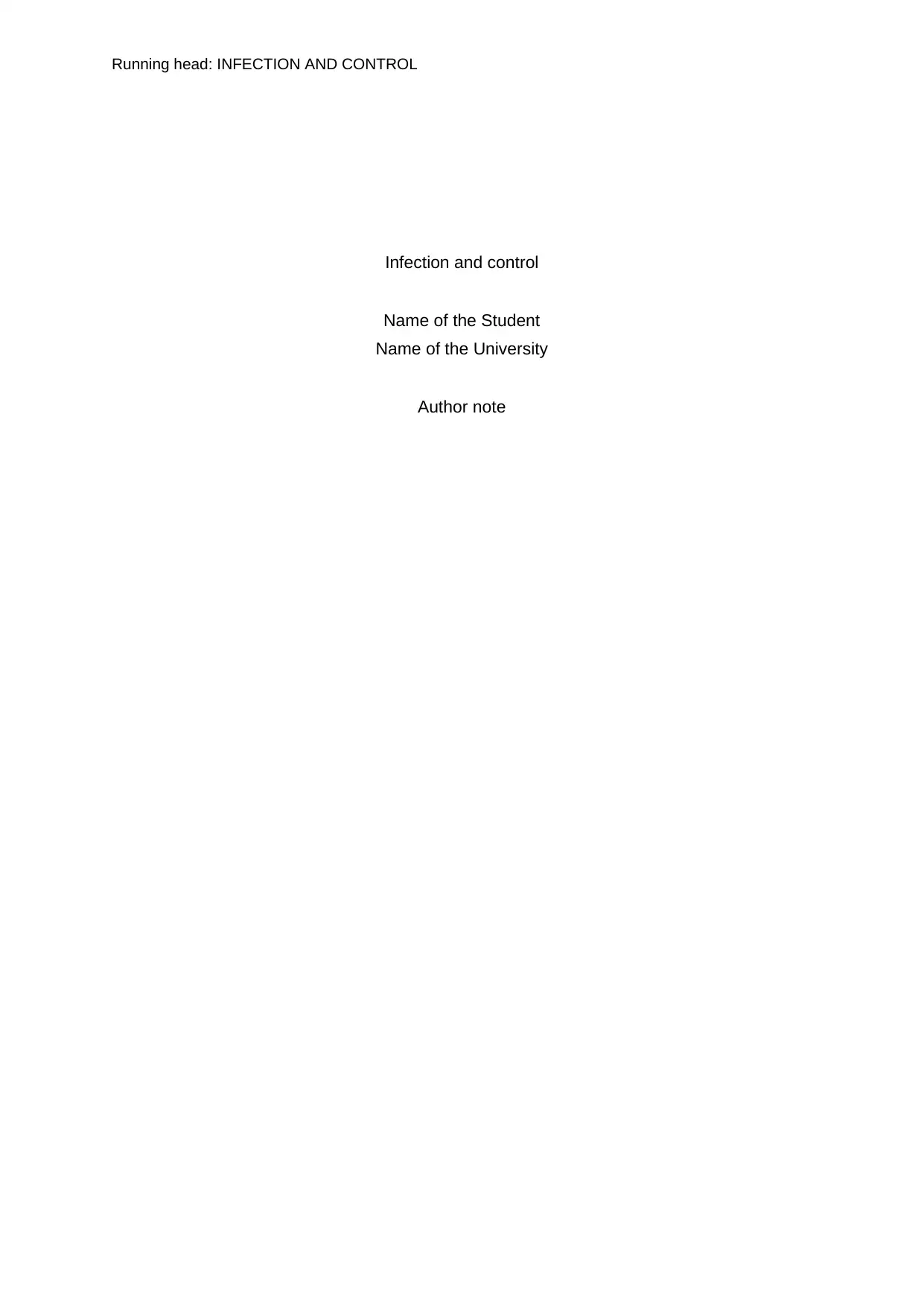
Running head: INFECTION AND CONTROL
Infection and control
Name of the Student
Name of the University
Author note
Infection and control
Name of the Student
Name of the University
Author note
Paraphrase This Document
Need a fresh take? Get an instant paraphrase of this document with our AI Paraphraser
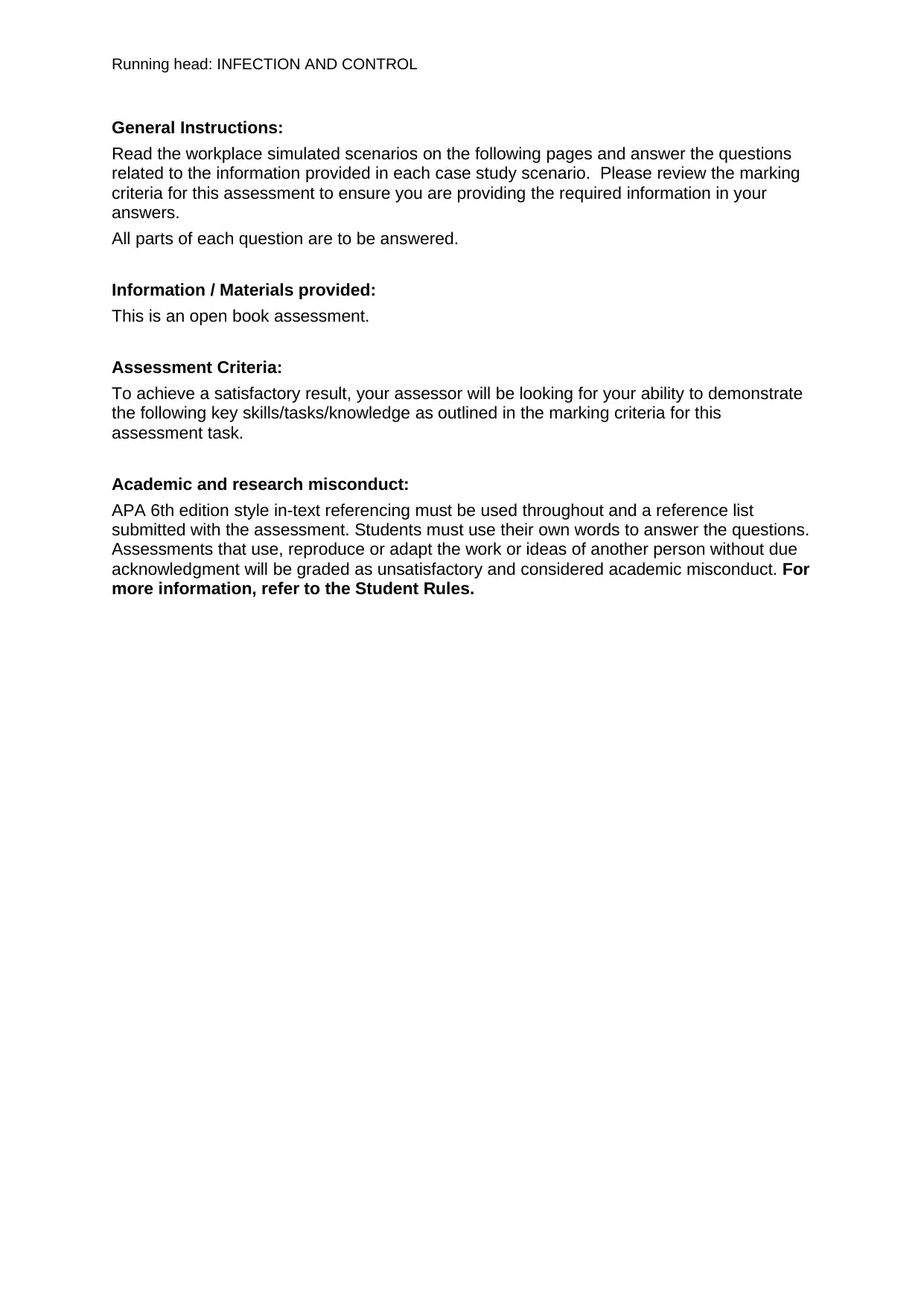
Running head: INFECTION AND CONTROL
General Instructions:
Read the workplace simulated scenarios on the following pages and answer the questions
related to the information provided in each case study scenario. Please review the marking
criteria for this assessment to ensure you are providing the required information in your
answers.
All parts of each question are to be answered.
Information / Materials provided:
This is an open book assessment.
Assessment Criteria:
To achieve a satisfactory result, your assessor will be looking for your ability to demonstrate
the following key skills/tasks/knowledge as outlined in the marking criteria for this
assessment task.
Academic and research misconduct:
APA 6th edition style in-text referencing must be used throughout and a reference list
submitted with the assessment. Students must use their own words to answer the questions.
Assessments that use, reproduce or adapt the work or ideas of another person without due
acknowledgment will be graded as unsatisfactory and considered academic misconduct. For
more information, refer to the Student Rules.
General Instructions:
Read the workplace simulated scenarios on the following pages and answer the questions
related to the information provided in each case study scenario. Please review the marking
criteria for this assessment to ensure you are providing the required information in your
answers.
All parts of each question are to be answered.
Information / Materials provided:
This is an open book assessment.
Assessment Criteria:
To achieve a satisfactory result, your assessor will be looking for your ability to demonstrate
the following key skills/tasks/knowledge as outlined in the marking criteria for this
assessment task.
Academic and research misconduct:
APA 6th edition style in-text referencing must be used throughout and a reference list
submitted with the assessment. Students must use their own words to answer the questions.
Assessments that use, reproduce or adapt the work or ideas of another person without due
acknowledgment will be graded as unsatisfactory and considered academic misconduct. For
more information, refer to the Student Rules.
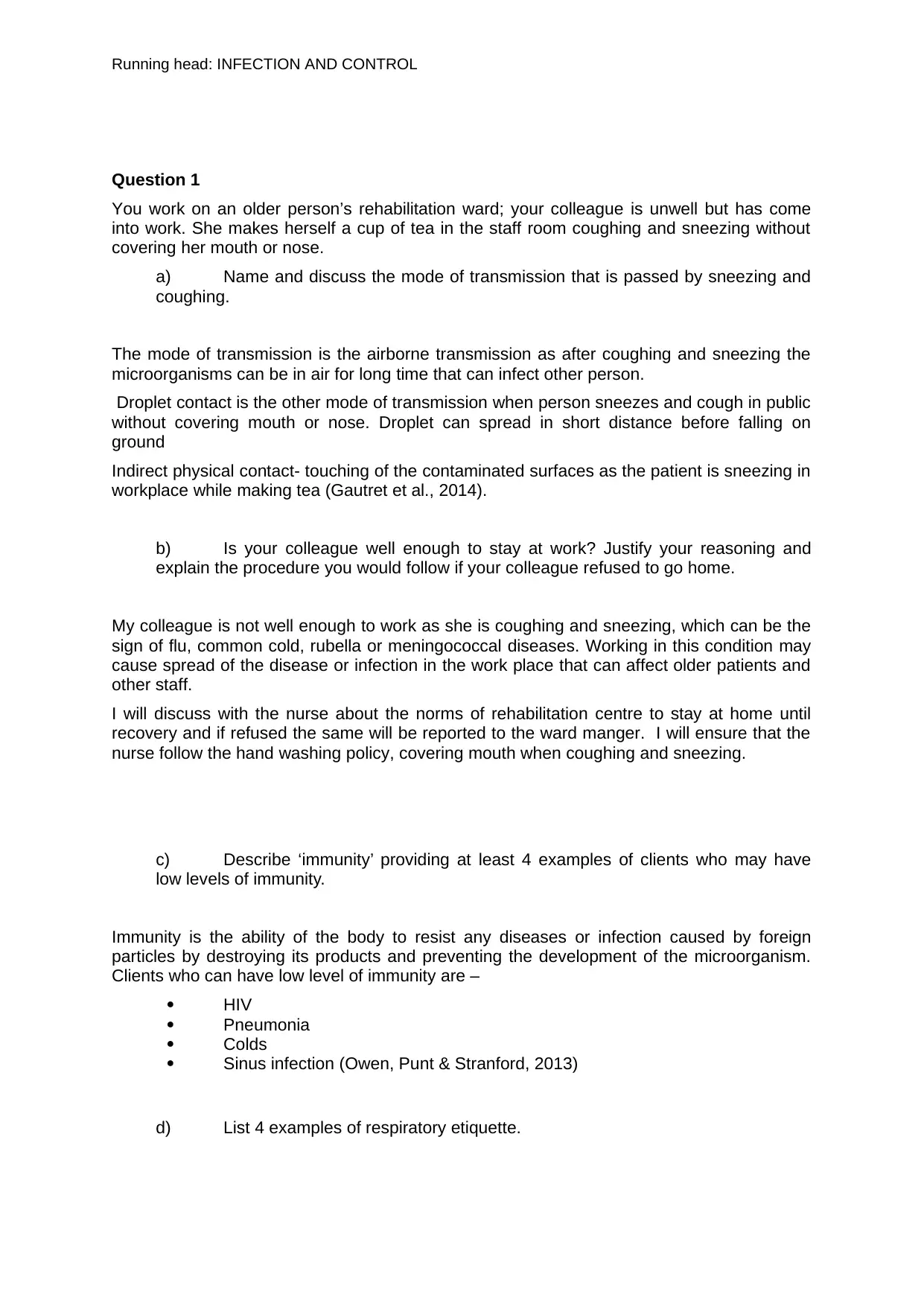
Running head: INFECTION AND CONTROL
Question 1
You work on an older person’s rehabilitation ward; your colleague is unwell but has come
into work. She makes herself a cup of tea in the staff room coughing and sneezing without
covering her mouth or nose.
a) Name and discuss the mode of transmission that is passed by sneezing and
coughing.
The mode of transmission is the airborne transmission as after coughing and sneezing the
microorganisms can be in air for long time that can infect other person.
Droplet contact is the other mode of transmission when person sneezes and cough in public
without covering mouth or nose. Droplet can spread in short distance before falling on
ground
Indirect physical contact- touching of the contaminated surfaces as the patient is sneezing in
workplace while making tea (Gautret et al., 2014).
b) Is your colleague well enough to stay at work? Justify your reasoning and
explain the procedure you would follow if your colleague refused to go home.
My colleague is not well enough to work as she is coughing and sneezing, which can be the
sign of flu, common cold, rubella or meningococcal diseases. Working in this condition may
cause spread of the disease or infection in the work place that can affect older patients and
other staff.
I will discuss with the nurse about the norms of rehabilitation centre to stay at home until
recovery and if refused the same will be reported to the ward manger. I will ensure that the
nurse follow the hand washing policy, covering mouth when coughing and sneezing.
c) Describe ‘immunity’ providing at least 4 examples of clients who may have
low levels of immunity.
Immunity is the ability of the body to resist any diseases or infection caused by foreign
particles by destroying its products and preventing the development of the microorganism.
Clients who can have low level of immunity are –
HIV
Pneumonia
Colds
Sinus infection (Owen, Punt & Stranford, 2013)
d) List 4 examples of respiratory etiquette.
Question 1
You work on an older person’s rehabilitation ward; your colleague is unwell but has come
into work. She makes herself a cup of tea in the staff room coughing and sneezing without
covering her mouth or nose.
a) Name and discuss the mode of transmission that is passed by sneezing and
coughing.
The mode of transmission is the airborne transmission as after coughing and sneezing the
microorganisms can be in air for long time that can infect other person.
Droplet contact is the other mode of transmission when person sneezes and cough in public
without covering mouth or nose. Droplet can spread in short distance before falling on
ground
Indirect physical contact- touching of the contaminated surfaces as the patient is sneezing in
workplace while making tea (Gautret et al., 2014).
b) Is your colleague well enough to stay at work? Justify your reasoning and
explain the procedure you would follow if your colleague refused to go home.
My colleague is not well enough to work as she is coughing and sneezing, which can be the
sign of flu, common cold, rubella or meningococcal diseases. Working in this condition may
cause spread of the disease or infection in the work place that can affect older patients and
other staff.
I will discuss with the nurse about the norms of rehabilitation centre to stay at home until
recovery and if refused the same will be reported to the ward manger. I will ensure that the
nurse follow the hand washing policy, covering mouth when coughing and sneezing.
c) Describe ‘immunity’ providing at least 4 examples of clients who may have
low levels of immunity.
Immunity is the ability of the body to resist any diseases or infection caused by foreign
particles by destroying its products and preventing the development of the microorganism.
Clients who can have low level of immunity are –
HIV
Pneumonia
Colds
Sinus infection (Owen, Punt & Stranford, 2013)
d) List 4 examples of respiratory etiquette.
⊘ This is a preview!⊘
Do you want full access?
Subscribe today to unlock all pages.

Trusted by 1+ million students worldwide
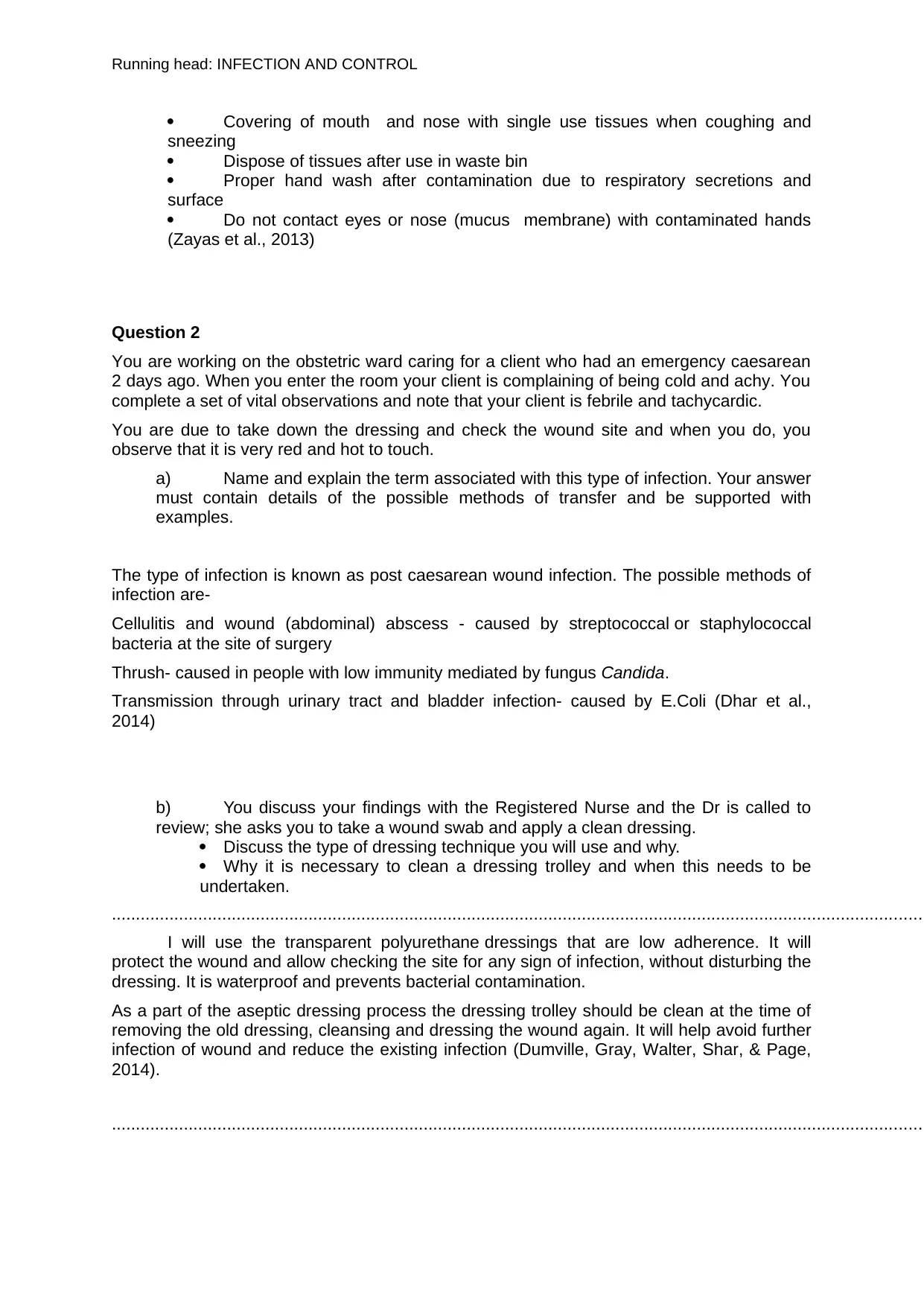
Running head: INFECTION AND CONTROL
Covering of mouth and nose with single use tissues when coughing and
sneezing
Dispose of tissues after use in waste bin
Proper hand wash after contamination due to respiratory secretions and
surface
Do not contact eyes or nose (mucus membrane) with contaminated hands
(Zayas et al., 2013)
Question 2
You are working on the obstetric ward caring for a client who had an emergency caesarean
2 days ago. When you enter the room your client is complaining of being cold and achy. You
complete a set of vital observations and note that your client is febrile and tachycardic.
You are due to take down the dressing and check the wound site and when you do, you
observe that it is very red and hot to touch.
a) Name and explain the term associated with this type of infection. Your answer
must contain details of the possible methods of transfer and be supported with
examples.
The type of infection is known as post caesarean wound infection. The possible methods of
infection are-
Cellulitis and wound (abdominal) abscess - caused by streptococcal or staphylococcal
bacteria at the site of surgery
Thrush- caused in people with low immunity mediated by fungus Candida.
Transmission through urinary tract and bladder infection- caused by E.Coli (Dhar et al.,
2014)
b) You discuss your findings with the Registered Nurse and the Dr is called to
review; she asks you to take a wound swab and apply a clean dressing.
Discuss the type of dressing technique you will use and why.
Why it is necessary to clean a dressing trolley and when this needs to be
undertaken.
.........................................................................................................................................................................
I will use the transparent polyurethane dressings that are low adherence. It will
protect the wound and allow checking the site for any sign of infection, without disturbing the
dressing. It is waterproof and prevents bacterial contamination.
As a part of the aseptic dressing process the dressing trolley should be clean at the time of
removing the old dressing, cleansing and dressing the wound again. It will help avoid further
infection of wound and reduce the existing infection (Dumville, Gray, Walter, Shar, & Page,
2014).
.........................................................................................................................................................................
Covering of mouth and nose with single use tissues when coughing and
sneezing
Dispose of tissues after use in waste bin
Proper hand wash after contamination due to respiratory secretions and
surface
Do not contact eyes or nose (mucus membrane) with contaminated hands
(Zayas et al., 2013)
Question 2
You are working on the obstetric ward caring for a client who had an emergency caesarean
2 days ago. When you enter the room your client is complaining of being cold and achy. You
complete a set of vital observations and note that your client is febrile and tachycardic.
You are due to take down the dressing and check the wound site and when you do, you
observe that it is very red and hot to touch.
a) Name and explain the term associated with this type of infection. Your answer
must contain details of the possible methods of transfer and be supported with
examples.
The type of infection is known as post caesarean wound infection. The possible methods of
infection are-
Cellulitis and wound (abdominal) abscess - caused by streptococcal or staphylococcal
bacteria at the site of surgery
Thrush- caused in people with low immunity mediated by fungus Candida.
Transmission through urinary tract and bladder infection- caused by E.Coli (Dhar et al.,
2014)
b) You discuss your findings with the Registered Nurse and the Dr is called to
review; she asks you to take a wound swab and apply a clean dressing.
Discuss the type of dressing technique you will use and why.
Why it is necessary to clean a dressing trolley and when this needs to be
undertaken.
.........................................................................................................................................................................
I will use the transparent polyurethane dressings that are low adherence. It will
protect the wound and allow checking the site for any sign of infection, without disturbing the
dressing. It is waterproof and prevents bacterial contamination.
As a part of the aseptic dressing process the dressing trolley should be clean at the time of
removing the old dressing, cleansing and dressing the wound again. It will help avoid further
infection of wound and reduce the existing infection (Dumville, Gray, Walter, Shar, & Page,
2014).
.........................................................................................................................................................................
Paraphrase This Document
Need a fresh take? Get an instant paraphrase of this document with our AI Paraphraser
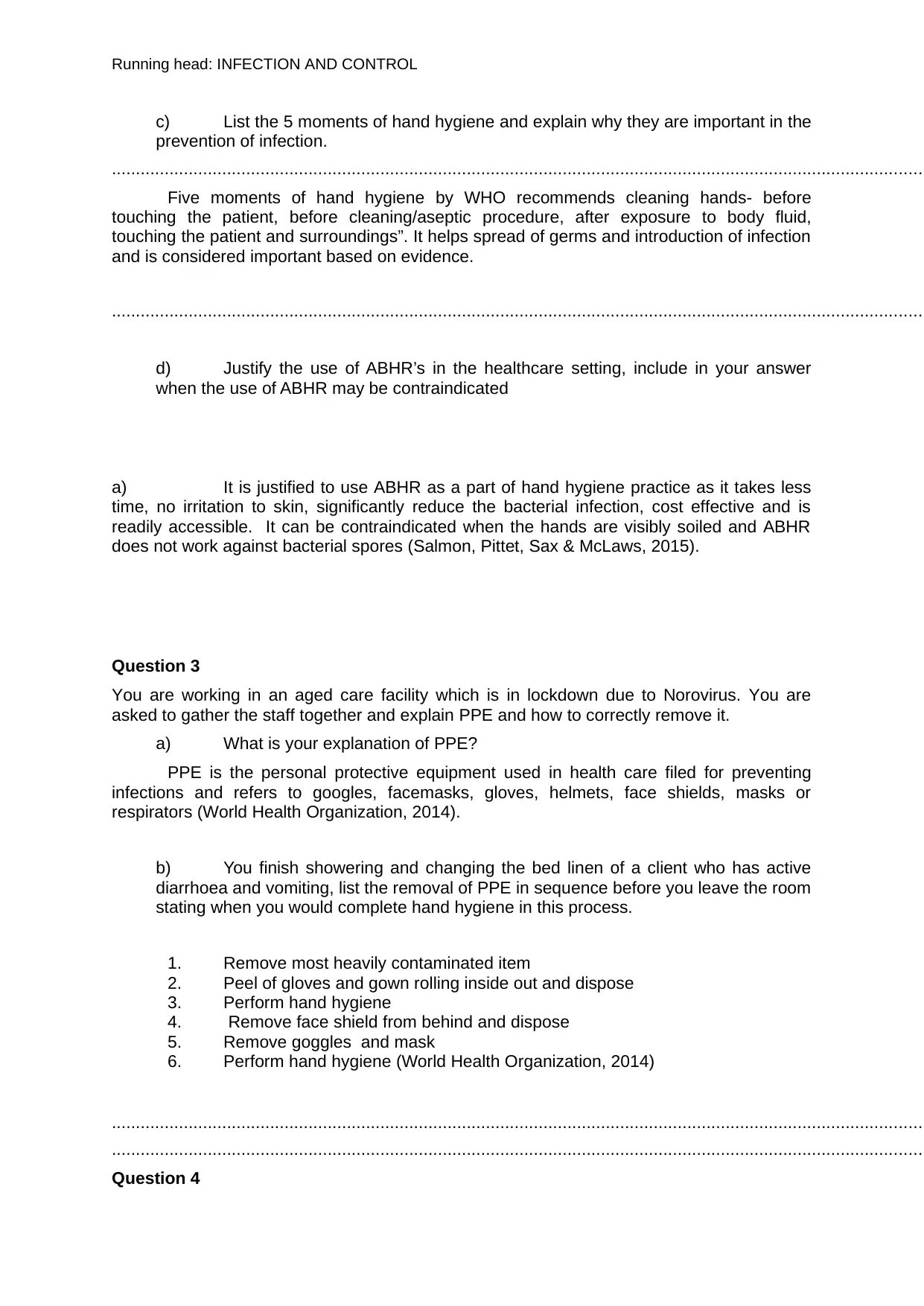
Running head: INFECTION AND CONTROL
c) List the 5 moments of hand hygiene and explain why they are important in the
prevention of infection.
.........................................................................................................................................................................
Five moments of hand hygiene by WHO recommends cleaning hands- before
touching the patient, before cleaning/aseptic procedure, after exposure to body fluid,
touching the patient and surroundings”. It helps spread of germs and introduction of infection
and is considered important based on evidence.
.........................................................................................................................................................................
d) Justify the use of ABHR’s in the healthcare setting, include in your answer
when the use of ABHR may be contraindicated
a) It is justified to use ABHR as a part of hand hygiene practice as it takes less
time, no irritation to skin, significantly reduce the bacterial infection, cost effective and is
readily accessible. It can be contraindicated when the hands are visibly soiled and ABHR
does not work against bacterial spores (Salmon, Pittet, Sax & McLaws, 2015).
Question 3
You are working in an aged care facility which is in lockdown due to Norovirus. You are
asked to gather the staff together and explain PPE and how to correctly remove it.
a) What is your explanation of PPE?
PPE is the personal protective equipment used in health care filed for preventing
infections and refers to googles, facemasks, gloves, helmets, face shields, masks or
respirators (World Health Organization, 2014).
b) You finish showering and changing the bed linen of a client who has active
diarrhoea and vomiting, list the removal of PPE in sequence before you leave the room
stating when you would complete hand hygiene in this process.
1. Remove most heavily contaminated item
2. Peel of gloves and gown rolling inside out and dispose
3. Perform hand hygiene
4. Remove face shield from behind and dispose
5. Remove goggles and mask
6. Perform hand hygiene (World Health Organization, 2014)
.........................................................................................................................................................................
.........................................................................................................................................................................
Question 4
c) List the 5 moments of hand hygiene and explain why they are important in the
prevention of infection.
.........................................................................................................................................................................
Five moments of hand hygiene by WHO recommends cleaning hands- before
touching the patient, before cleaning/aseptic procedure, after exposure to body fluid,
touching the patient and surroundings”. It helps spread of germs and introduction of infection
and is considered important based on evidence.
.........................................................................................................................................................................
d) Justify the use of ABHR’s in the healthcare setting, include in your answer
when the use of ABHR may be contraindicated
a) It is justified to use ABHR as a part of hand hygiene practice as it takes less
time, no irritation to skin, significantly reduce the bacterial infection, cost effective and is
readily accessible. It can be contraindicated when the hands are visibly soiled and ABHR
does not work against bacterial spores (Salmon, Pittet, Sax & McLaws, 2015).
Question 3
You are working in an aged care facility which is in lockdown due to Norovirus. You are
asked to gather the staff together and explain PPE and how to correctly remove it.
a) What is your explanation of PPE?
PPE is the personal protective equipment used in health care filed for preventing
infections and refers to googles, facemasks, gloves, helmets, face shields, masks or
respirators (World Health Organization, 2014).
b) You finish showering and changing the bed linen of a client who has active
diarrhoea and vomiting, list the removal of PPE in sequence before you leave the room
stating when you would complete hand hygiene in this process.
1. Remove most heavily contaminated item
2. Peel of gloves and gown rolling inside out and dispose
3. Perform hand hygiene
4. Remove face shield from behind and dispose
5. Remove goggles and mask
6. Perform hand hygiene (World Health Organization, 2014)
.........................................................................................................................................................................
.........................................................................................................................................................................
Question 4
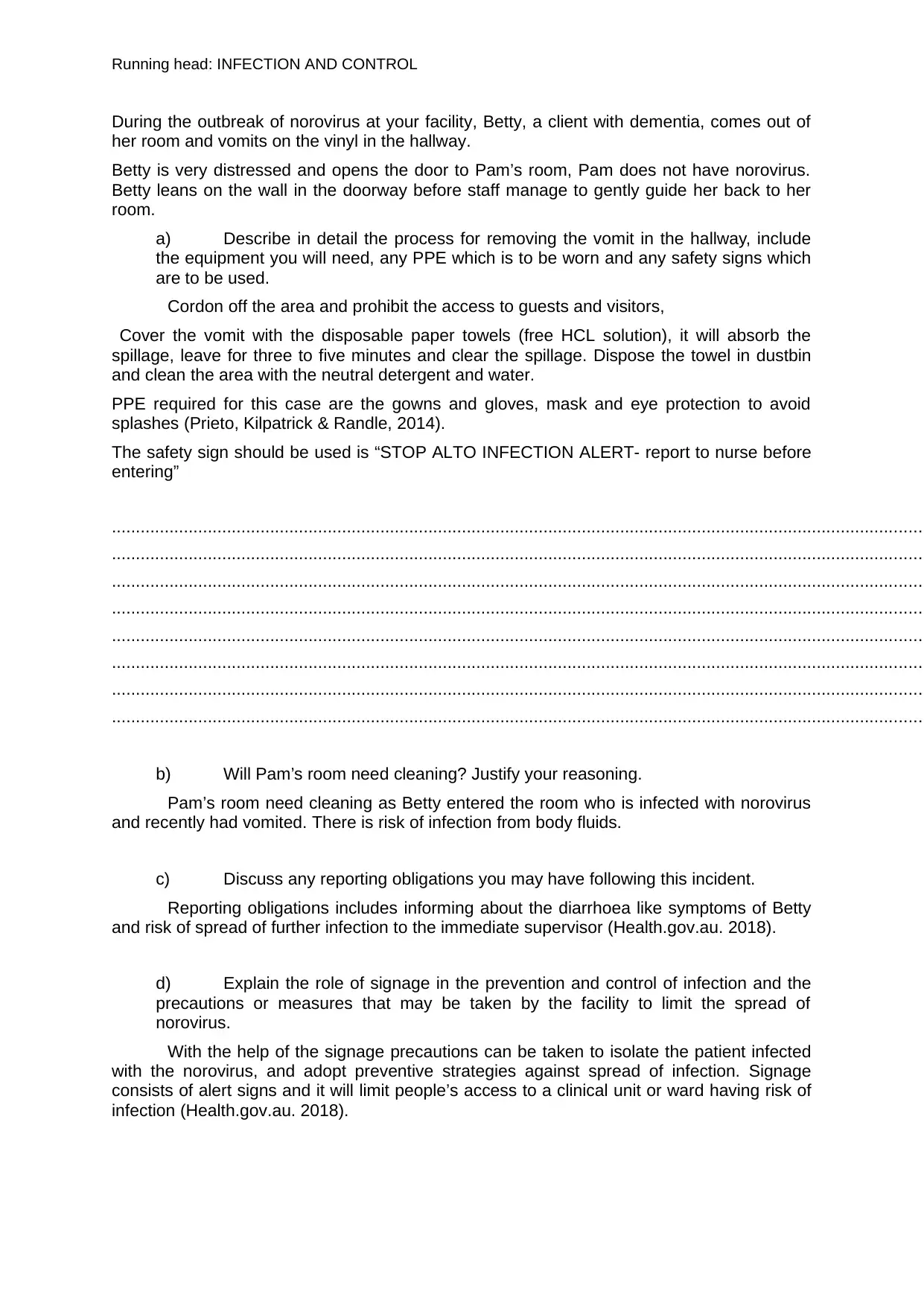
Running head: INFECTION AND CONTROL
During the outbreak of norovirus at your facility, Betty, a client with dementia, comes out of
her room and vomits on the vinyl in the hallway.
Betty is very distressed and opens the door to Pam’s room, Pam does not have norovirus.
Betty leans on the wall in the doorway before staff manage to gently guide her back to her
room.
a) Describe in detail the process for removing the vomit in the hallway, include
the equipment you will need, any PPE which is to be worn and any safety signs which
are to be used.
Cordon off the area and prohibit the access to guests and visitors,
Cover the vomit with the disposable paper towels (free HCL solution), it will absorb the
spillage, leave for three to five minutes and clear the spillage. Dispose the towel in dustbin
and clean the area with the neutral detergent and water.
PPE required for this case are the gowns and gloves, mask and eye protection to avoid
splashes (Prieto, Kilpatrick & Randle, 2014).
The safety sign should be used is “STOP ALTO INFECTION ALERT- report to nurse before
entering”
.........................................................................................................................................................................
.........................................................................................................................................................................
.........................................................................................................................................................................
.........................................................................................................................................................................
.........................................................................................................................................................................
.........................................................................................................................................................................
.........................................................................................................................................................................
.........................................................................................................................................................................
b) Will Pam’s room need cleaning? Justify your reasoning.
Pam’s room need cleaning as Betty entered the room who is infected with norovirus
and recently had vomited. There is risk of infection from body fluids.
c) Discuss any reporting obligations you may have following this incident.
Reporting obligations includes informing about the diarrhoea like symptoms of Betty
and risk of spread of further infection to the immediate supervisor (Health.gov.au. 2018).
d) Explain the role of signage in the prevention and control of infection and the
precautions or measures that may be taken by the facility to limit the spread of
norovirus.
With the help of the signage precautions can be taken to isolate the patient infected
with the norovirus, and adopt preventive strategies against spread of infection. Signage
consists of alert signs and it will limit people’s access to a clinical unit or ward having risk of
infection (Health.gov.au. 2018).
During the outbreak of norovirus at your facility, Betty, a client with dementia, comes out of
her room and vomits on the vinyl in the hallway.
Betty is very distressed and opens the door to Pam’s room, Pam does not have norovirus.
Betty leans on the wall in the doorway before staff manage to gently guide her back to her
room.
a) Describe in detail the process for removing the vomit in the hallway, include
the equipment you will need, any PPE which is to be worn and any safety signs which
are to be used.
Cordon off the area and prohibit the access to guests and visitors,
Cover the vomit with the disposable paper towels (free HCL solution), it will absorb the
spillage, leave for three to five minutes and clear the spillage. Dispose the towel in dustbin
and clean the area with the neutral detergent and water.
PPE required for this case are the gowns and gloves, mask and eye protection to avoid
splashes (Prieto, Kilpatrick & Randle, 2014).
The safety sign should be used is “STOP ALTO INFECTION ALERT- report to nurse before
entering”
.........................................................................................................................................................................
.........................................................................................................................................................................
.........................................................................................................................................................................
.........................................................................................................................................................................
.........................................................................................................................................................................
.........................................................................................................................................................................
.........................................................................................................................................................................
.........................................................................................................................................................................
b) Will Pam’s room need cleaning? Justify your reasoning.
Pam’s room need cleaning as Betty entered the room who is infected with norovirus
and recently had vomited. There is risk of infection from body fluids.
c) Discuss any reporting obligations you may have following this incident.
Reporting obligations includes informing about the diarrhoea like symptoms of Betty
and risk of spread of further infection to the immediate supervisor (Health.gov.au. 2018).
d) Explain the role of signage in the prevention and control of infection and the
precautions or measures that may be taken by the facility to limit the spread of
norovirus.
With the help of the signage precautions can be taken to isolate the patient infected
with the norovirus, and adopt preventive strategies against spread of infection. Signage
consists of alert signs and it will limit people’s access to a clinical unit or ward having risk of
infection (Health.gov.au. 2018).
⊘ This is a preview!⊘
Do you want full access?
Subscribe today to unlock all pages.

Trusted by 1+ million students worldwide
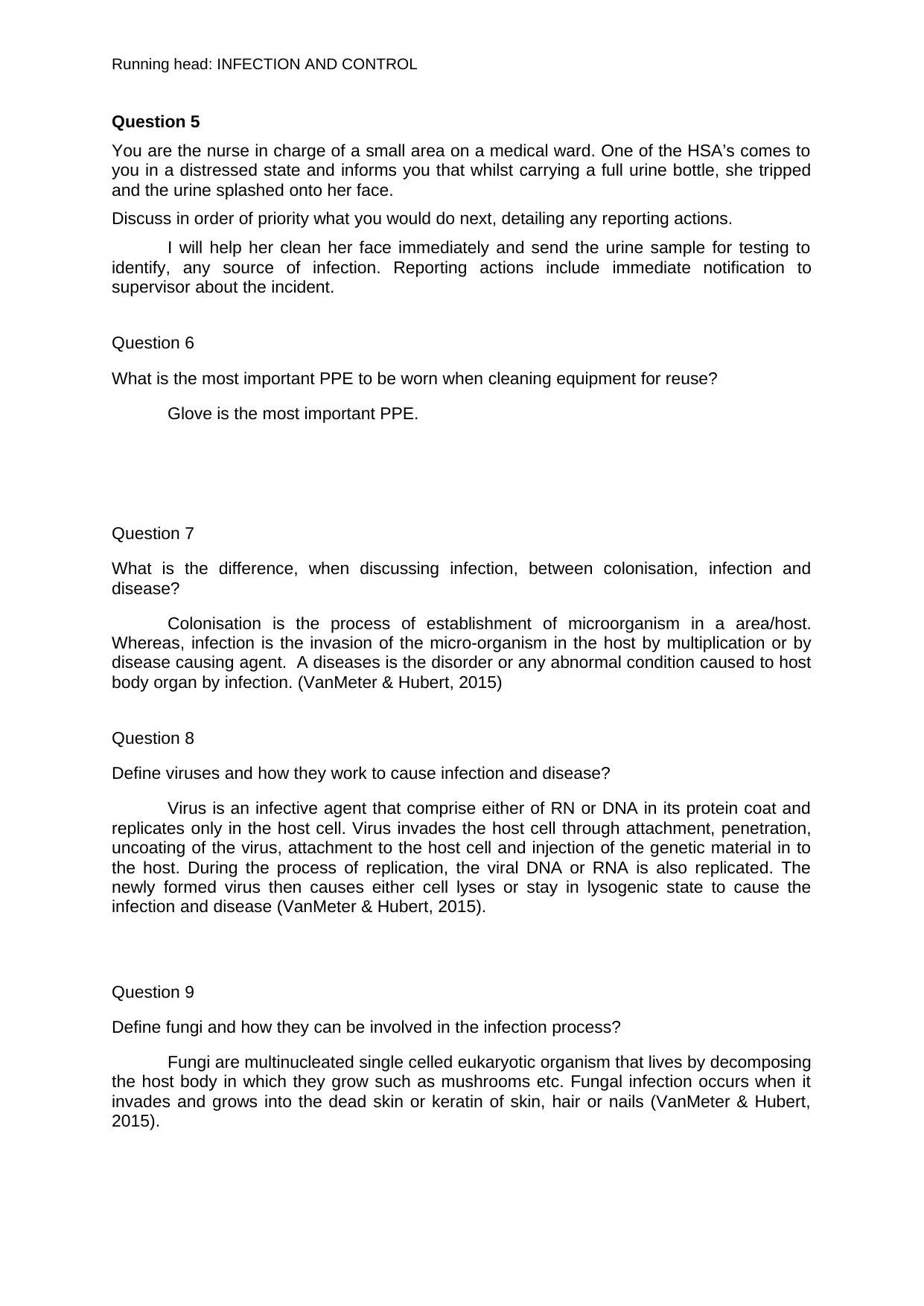
Running head: INFECTION AND CONTROL
Question 5
You are the nurse in charge of a small area on a medical ward. One of the HSA’s comes to
you in a distressed state and informs you that whilst carrying a full urine bottle, she tripped
and the urine splashed onto her face.
Discuss in order of priority what you would do next, detailing any reporting actions.
I will help her clean her face immediately and send the urine sample for testing to
identify, any source of infection. Reporting actions include immediate notification to
supervisor about the incident.
Question 6
What is the most important PPE to be worn when cleaning equipment for reuse?
Glove is the most important PPE.
Question 7
What is the difference, when discussing infection, between colonisation, infection and
disease?
Colonisation is the process of establishment of microorganism in a area/host.
Whereas, infection is the invasion of the micro-organism in the host by multiplication or by
disease causing agent. A diseases is the disorder or any abnormal condition caused to host
body organ by infection. (VanMeter & Hubert, 2015)
Question 8
Define viruses and how they work to cause infection and disease?
Virus is an infective agent that comprise either of RN or DNA in its protein coat and
replicates only in the host cell. Virus invades the host cell through attachment, penetration,
uncoating of the virus, attachment to the host cell and injection of the genetic material in to
the host. During the process of replication, the viral DNA or RNA is also replicated. The
newly formed virus then causes either cell lyses or stay in lysogenic state to cause the
infection and disease (VanMeter & Hubert, 2015).
Question 9
Define fungi and how they can be involved in the infection process?
Fungi are multinucleated single celled eukaryotic organism that lives by decomposing
the host body in which they grow such as mushrooms etc. Fungal infection occurs when it
invades and grows into the dead skin or keratin of skin, hair or nails (VanMeter & Hubert,
2015).
Question 5
You are the nurse in charge of a small area on a medical ward. One of the HSA’s comes to
you in a distressed state and informs you that whilst carrying a full urine bottle, she tripped
and the urine splashed onto her face.
Discuss in order of priority what you would do next, detailing any reporting actions.
I will help her clean her face immediately and send the urine sample for testing to
identify, any source of infection. Reporting actions include immediate notification to
supervisor about the incident.
Question 6
What is the most important PPE to be worn when cleaning equipment for reuse?
Glove is the most important PPE.
Question 7
What is the difference, when discussing infection, between colonisation, infection and
disease?
Colonisation is the process of establishment of microorganism in a area/host.
Whereas, infection is the invasion of the micro-organism in the host by multiplication or by
disease causing agent. A diseases is the disorder or any abnormal condition caused to host
body organ by infection. (VanMeter & Hubert, 2015)
Question 8
Define viruses and how they work to cause infection and disease?
Virus is an infective agent that comprise either of RN or DNA in its protein coat and
replicates only in the host cell. Virus invades the host cell through attachment, penetration,
uncoating of the virus, attachment to the host cell and injection of the genetic material in to
the host. During the process of replication, the viral DNA or RNA is also replicated. The
newly formed virus then causes either cell lyses or stay in lysogenic state to cause the
infection and disease (VanMeter & Hubert, 2015).
Question 9
Define fungi and how they can be involved in the infection process?
Fungi are multinucleated single celled eukaryotic organism that lives by decomposing
the host body in which they grow such as mushrooms etc. Fungal infection occurs when it
invades and grows into the dead skin or keratin of skin, hair or nails (VanMeter & Hubert,
2015).
Paraphrase This Document
Need a fresh take? Get an instant paraphrase of this document with our AI Paraphraser
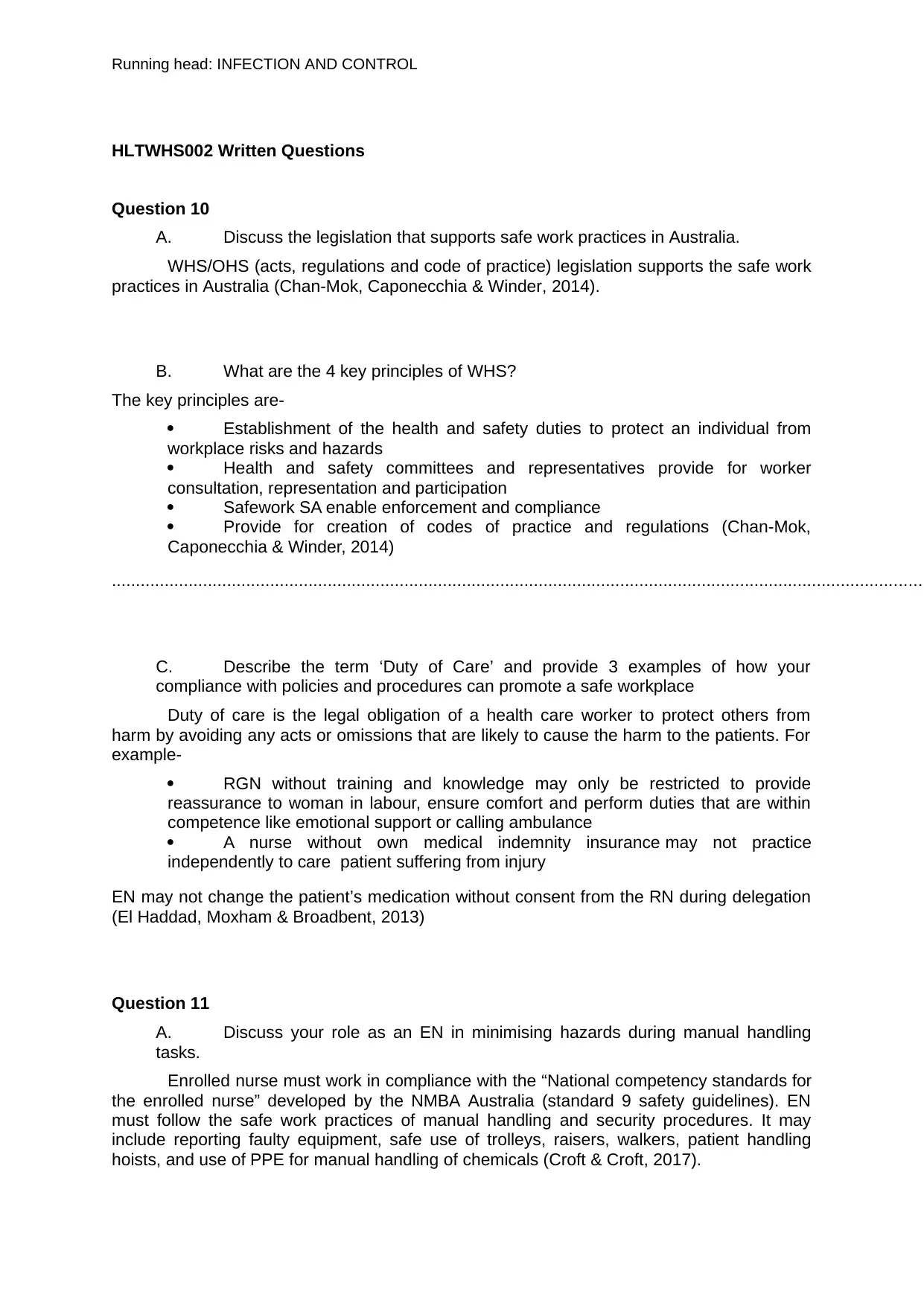
Running head: INFECTION AND CONTROL
HLTWHS002 Written Questions
Question 10
A. Discuss the legislation that supports safe work practices in Australia.
WHS/OHS (acts, regulations and code of practice) legislation supports the safe work
practices in Australia (Chan-Mok, Caponecchia & Winder, 2014).
B. What are the 4 key principles of WHS?
The key principles are-
Establishment of the health and safety duties to protect an individual from
workplace risks and hazards
Health and safety committees and representatives provide for worker
consultation, representation and participation
Safework SA enable enforcement and compliance
Provide for creation of codes of practice and regulations (Chan-Mok,
Caponecchia & Winder, 2014)
.........................................................................................................................................................................
C. Describe the term ‘Duty of Care’ and provide 3 examples of how your
compliance with policies and procedures can promote a safe workplace
Duty of care is the legal obligation of a health care worker to protect others from
harm by avoiding any acts or omissions that are likely to cause the harm to the patients. For
example-
RGN without training and knowledge may only be restricted to provide
reassurance to woman in labour, ensure comfort and perform duties that are within
competence like emotional support or calling ambulance
A nurse without own medical indemnity insurance may not practice
independently to care patient suffering from injury
EN may not change the patient’s medication without consent from the RN during delegation
(El Haddad, Moxham & Broadbent, 2013)
Question 11
A. Discuss your role as an EN in minimising hazards during manual handling
tasks.
Enrolled nurse must work in compliance with the “National competency standards for
the enrolled nurse” developed by the NMBA Australia (standard 9 safety guidelines). EN
must follow the safe work practices of manual handling and security procedures. It may
include reporting faulty equipment, safe use of trolleys, raisers, walkers, patient handling
hoists, and use of PPE for manual handling of chemicals (Croft & Croft, 2017).
HLTWHS002 Written Questions
Question 10
A. Discuss the legislation that supports safe work practices in Australia.
WHS/OHS (acts, regulations and code of practice) legislation supports the safe work
practices in Australia (Chan-Mok, Caponecchia & Winder, 2014).
B. What are the 4 key principles of WHS?
The key principles are-
Establishment of the health and safety duties to protect an individual from
workplace risks and hazards
Health and safety committees and representatives provide for worker
consultation, representation and participation
Safework SA enable enforcement and compliance
Provide for creation of codes of practice and regulations (Chan-Mok,
Caponecchia & Winder, 2014)
.........................................................................................................................................................................
C. Describe the term ‘Duty of Care’ and provide 3 examples of how your
compliance with policies and procedures can promote a safe workplace
Duty of care is the legal obligation of a health care worker to protect others from
harm by avoiding any acts or omissions that are likely to cause the harm to the patients. For
example-
RGN without training and knowledge may only be restricted to provide
reassurance to woman in labour, ensure comfort and perform duties that are within
competence like emotional support or calling ambulance
A nurse without own medical indemnity insurance may not practice
independently to care patient suffering from injury
EN may not change the patient’s medication without consent from the RN during delegation
(El Haddad, Moxham & Broadbent, 2013)
Question 11
A. Discuss your role as an EN in minimising hazards during manual handling
tasks.
Enrolled nurse must work in compliance with the “National competency standards for
the enrolled nurse” developed by the NMBA Australia (standard 9 safety guidelines). EN
must follow the safe work practices of manual handling and security procedures. It may
include reporting faulty equipment, safe use of trolleys, raisers, walkers, patient handling
hoists, and use of PPE for manual handling of chemicals (Croft & Croft, 2017).
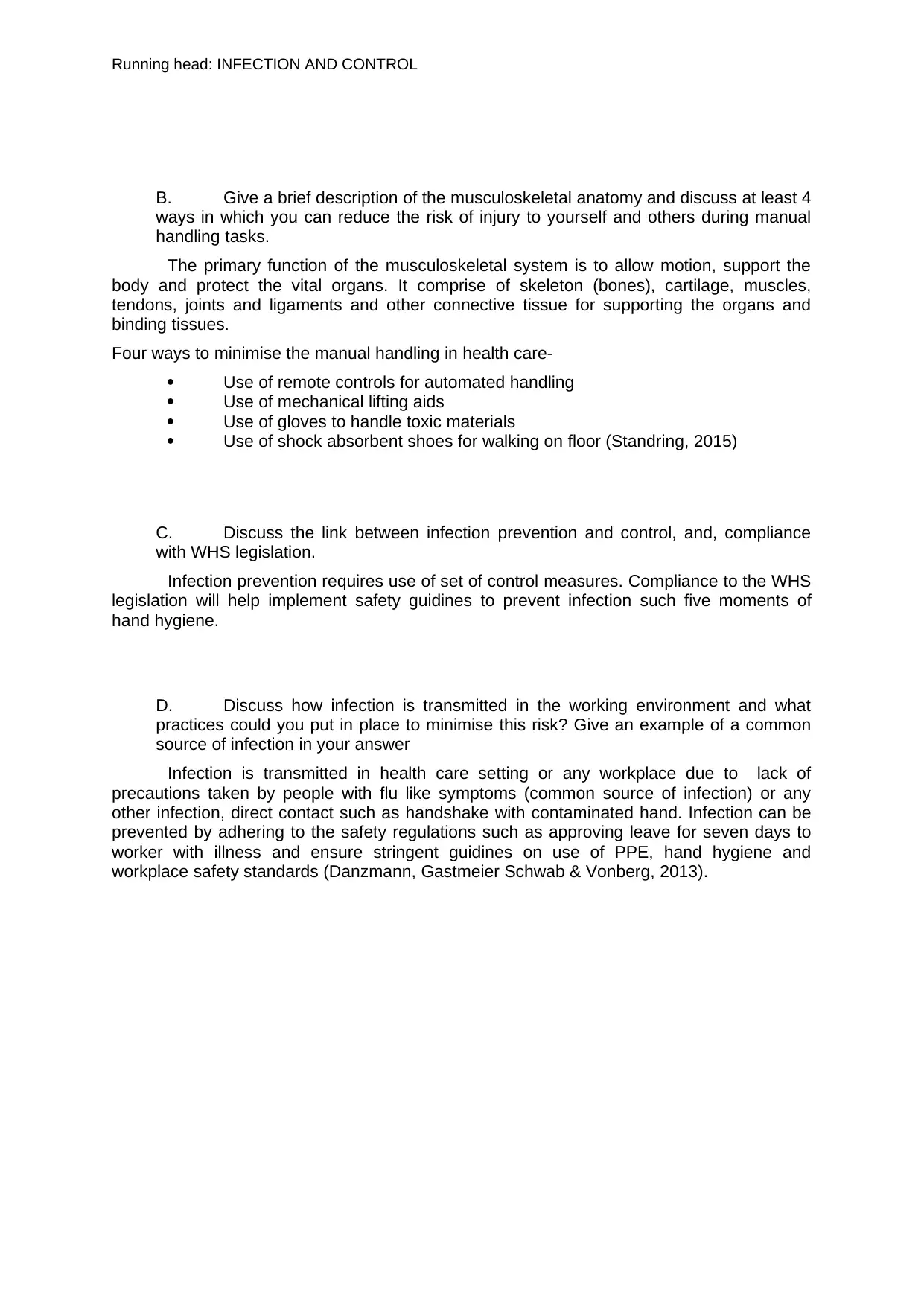
Running head: INFECTION AND CONTROL
B. Give a brief description of the musculoskeletal anatomy and discuss at least 4
ways in which you can reduce the risk of injury to yourself and others during manual
handling tasks.
The primary function of the musculoskeletal system is to allow motion, support the
body and protect the vital organs. It comprise of skeleton (bones), cartilage, muscles,
tendons, joints and ligaments and other connective tissue for supporting the organs and
binding tissues.
Four ways to minimise the manual handling in health care-
Use of remote controls for automated handling
Use of mechanical lifting aids
Use of gloves to handle toxic materials
Use of shock absorbent shoes for walking on floor (Standring, 2015)
C. Discuss the link between infection prevention and control, and, compliance
with WHS legislation.
Infection prevention requires use of set of control measures. Compliance to the WHS
legislation will help implement safety guidines to prevent infection such five moments of
hand hygiene.
D. Discuss how infection is transmitted in the working environment and what
practices could you put in place to minimise this risk? Give an example of a common
source of infection in your answer
Infection is transmitted in health care setting or any workplace due to lack of
precautions taken by people with flu like symptoms (common source of infection) or any
other infection, direct contact such as handshake with contaminated hand. Infection can be
prevented by adhering to the safety regulations such as approving leave for seven days to
worker with illness and ensure stringent guidines on use of PPE, hand hygiene and
workplace safety standards (Danzmann, Gastmeier Schwab & Vonberg, 2013).
B. Give a brief description of the musculoskeletal anatomy and discuss at least 4
ways in which you can reduce the risk of injury to yourself and others during manual
handling tasks.
The primary function of the musculoskeletal system is to allow motion, support the
body and protect the vital organs. It comprise of skeleton (bones), cartilage, muscles,
tendons, joints and ligaments and other connective tissue for supporting the organs and
binding tissues.
Four ways to minimise the manual handling in health care-
Use of remote controls for automated handling
Use of mechanical lifting aids
Use of gloves to handle toxic materials
Use of shock absorbent shoes for walking on floor (Standring, 2015)
C. Discuss the link between infection prevention and control, and, compliance
with WHS legislation.
Infection prevention requires use of set of control measures. Compliance to the WHS
legislation will help implement safety guidines to prevent infection such five moments of
hand hygiene.
D. Discuss how infection is transmitted in the working environment and what
practices could you put in place to minimise this risk? Give an example of a common
source of infection in your answer
Infection is transmitted in health care setting or any workplace due to lack of
precautions taken by people with flu like symptoms (common source of infection) or any
other infection, direct contact such as handshake with contaminated hand. Infection can be
prevented by adhering to the safety regulations such as approving leave for seven days to
worker with illness and ensure stringent guidines on use of PPE, hand hygiene and
workplace safety standards (Danzmann, Gastmeier Schwab & Vonberg, 2013).
⊘ This is a preview!⊘
Do you want full access?
Subscribe today to unlock all pages.

Trusted by 1+ million students worldwide
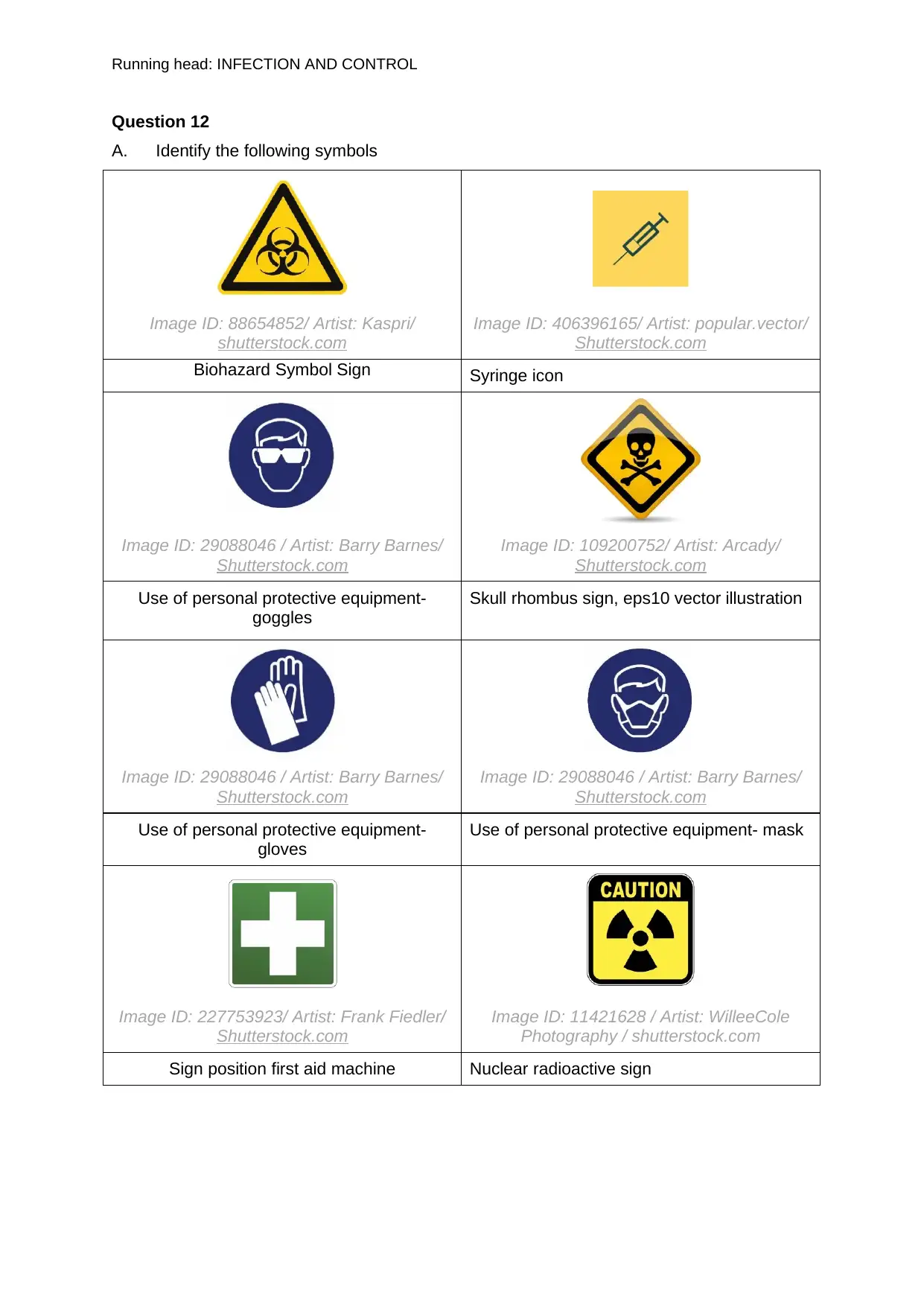
Running head: INFECTION AND CONTROL
Question 12
A. Identify the following symbols
Image ID: 88654852/ Artist: Kaspri/
shutterstock.com
Image ID: 406396165/ Artist: popular.vector/
Shutterstock.com
Biohazard Symbol Sign Syringe icon
Image ID: 29088046 / Artist: Barry Barnes/
Shutterstock.com
Image ID: 109200752/ Artist: Arcady/
Shutterstock.com
Use of personal protective equipment-
goggles
Skull rhombus sign, eps10 vector illustration
Image ID: 29088046 / Artist: Barry Barnes/
Shutterstock.com
Image ID: 29088046 / Artist: Barry Barnes/
Shutterstock.com
Use of personal protective equipment-
gloves
Use of personal protective equipment- mask
Image ID: 227753923/ Artist: Frank Fiedler/
Shutterstock.com
Image ID: 11421628 / Artist: WilleeCole
Photography / shutterstock.com
Sign position first aid machine Nuclear radioactive sign
Question 12
A. Identify the following symbols
Image ID: 88654852/ Artist: Kaspri/
shutterstock.com
Image ID: 406396165/ Artist: popular.vector/
Shutterstock.com
Biohazard Symbol Sign Syringe icon
Image ID: 29088046 / Artist: Barry Barnes/
Shutterstock.com
Image ID: 109200752/ Artist: Arcady/
Shutterstock.com
Use of personal protective equipment-
goggles
Skull rhombus sign, eps10 vector illustration
Image ID: 29088046 / Artist: Barry Barnes/
Shutterstock.com
Image ID: 29088046 / Artist: Barry Barnes/
Shutterstock.com
Use of personal protective equipment-
gloves
Use of personal protective equipment- mask
Image ID: 227753923/ Artist: Frank Fiedler/
Shutterstock.com
Image ID: 11421628 / Artist: WilleeCole
Photography / shutterstock.com
Sign position first aid machine Nuclear radioactive sign
Paraphrase This Document
Need a fresh take? Get an instant paraphrase of this document with our AI Paraphraser
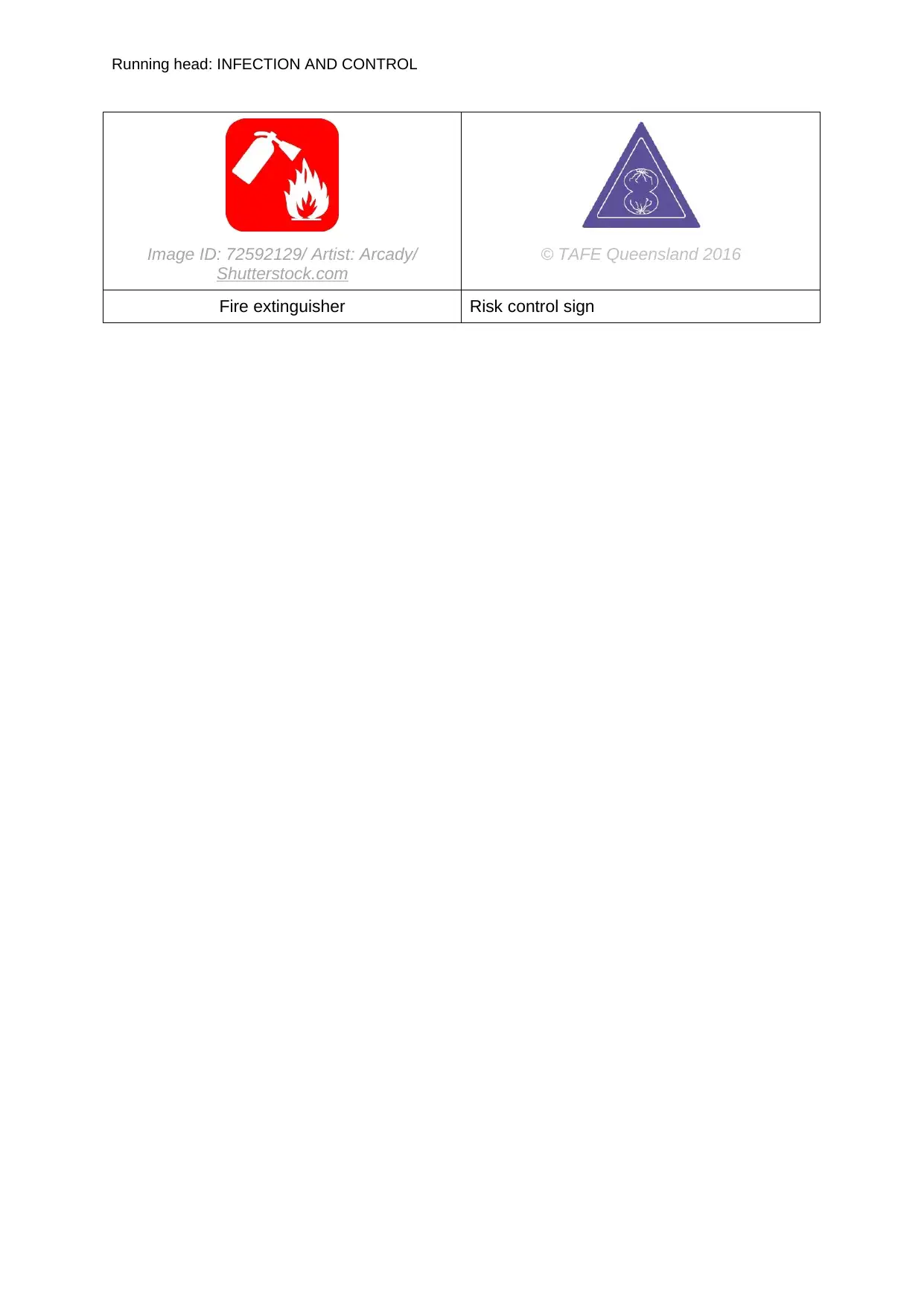
Running head: INFECTION AND CONTROL
Image ID: 72592129/ Artist: Arcady/
Shutterstock.com
© TAFE Queensland 2016
Fire extinguisher Risk control sign
Image ID: 72592129/ Artist: Arcady/
Shutterstock.com
© TAFE Queensland 2016
Fire extinguisher Risk control sign
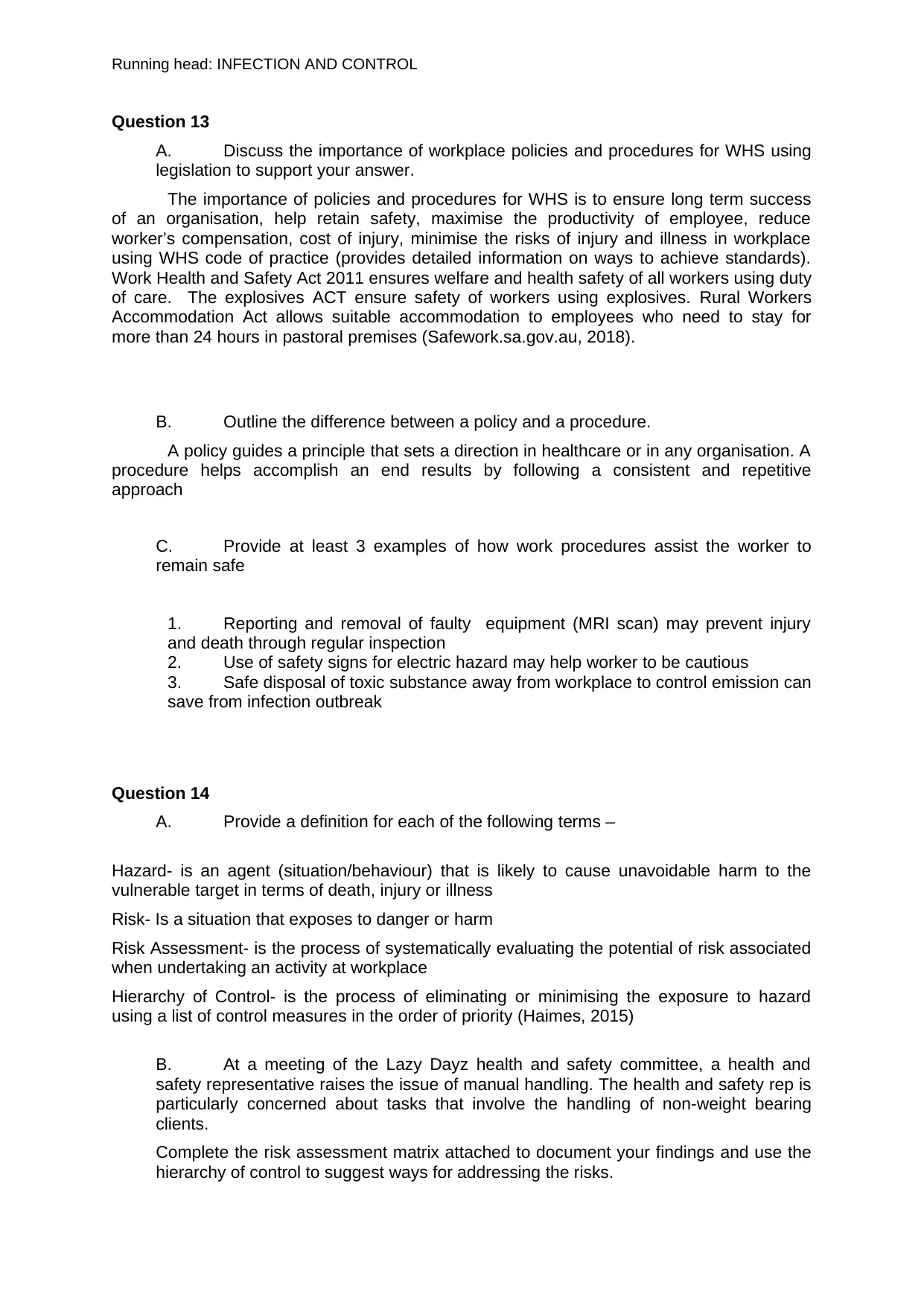
Running head: INFECTION AND CONTROL
Question 13
A. Discuss the importance of workplace policies and procedures for WHS using
legislation to support your answer.
The importance of policies and procedures for WHS is to ensure long term success
of an organisation, help retain safety, maximise the productivity of employee, reduce
worker’s compensation, cost of injury, minimise the risks of injury and illness in workplace
using WHS code of practice (provides detailed information on ways to achieve standards).
Work Health and Safety Act 2011 ensures welfare and health safety of all workers using duty
of care. The explosives ACT ensure safety of workers using explosives. Rural Workers
Accommodation Act allows suitable accommodation to employees who need to stay for
more than 24 hours in pastoral premises (Safework.sa.gov.au, 2018).
B. Outline the difference between a policy and a procedure.
A policy guides a principle that sets a direction in healthcare or in any organisation. A
procedure helps accomplish an end results by following a consistent and repetitive
approach
C. Provide at least 3 examples of how work procedures assist the worker to
remain safe
1. Reporting and removal of faulty equipment (MRI scan) may prevent injury
and death through regular inspection
2. Use of safety signs for electric hazard may help worker to be cautious
3. Safe disposal of toxic substance away from workplace to control emission can
save from infection outbreak
Question 14
A. Provide a definition for each of the following terms –
Hazard- is an agent (situation/behaviour) that is likely to cause unavoidable harm to the
vulnerable target in terms of death, injury or illness
Risk- Is a situation that exposes to danger or harm
Risk Assessment- is the process of systematically evaluating the potential of risk associated
when undertaking an activity at workplace
Hierarchy of Control- is the process of eliminating or minimising the exposure to hazard
using a list of control measures in the order of priority (Haimes, 2015)
B. At a meeting of the Lazy Dayz health and safety committee, a health and
safety representative raises the issue of manual handling. The health and safety rep is
particularly concerned about tasks that involve the handling of non-weight bearing
clients.
Complete the risk assessment matrix attached to document your findings and use the
hierarchy of control to suggest ways for addressing the risks.
Question 13
A. Discuss the importance of workplace policies and procedures for WHS using
legislation to support your answer.
The importance of policies and procedures for WHS is to ensure long term success
of an organisation, help retain safety, maximise the productivity of employee, reduce
worker’s compensation, cost of injury, minimise the risks of injury and illness in workplace
using WHS code of practice (provides detailed information on ways to achieve standards).
Work Health and Safety Act 2011 ensures welfare and health safety of all workers using duty
of care. The explosives ACT ensure safety of workers using explosives. Rural Workers
Accommodation Act allows suitable accommodation to employees who need to stay for
more than 24 hours in pastoral premises (Safework.sa.gov.au, 2018).
B. Outline the difference between a policy and a procedure.
A policy guides a principle that sets a direction in healthcare or in any organisation. A
procedure helps accomplish an end results by following a consistent and repetitive
approach
C. Provide at least 3 examples of how work procedures assist the worker to
remain safe
1. Reporting and removal of faulty equipment (MRI scan) may prevent injury
and death through regular inspection
2. Use of safety signs for electric hazard may help worker to be cautious
3. Safe disposal of toxic substance away from workplace to control emission can
save from infection outbreak
Question 14
A. Provide a definition for each of the following terms –
Hazard- is an agent (situation/behaviour) that is likely to cause unavoidable harm to the
vulnerable target in terms of death, injury or illness
Risk- Is a situation that exposes to danger or harm
Risk Assessment- is the process of systematically evaluating the potential of risk associated
when undertaking an activity at workplace
Hierarchy of Control- is the process of eliminating or minimising the exposure to hazard
using a list of control measures in the order of priority (Haimes, 2015)
B. At a meeting of the Lazy Dayz health and safety committee, a health and
safety representative raises the issue of manual handling. The health and safety rep is
particularly concerned about tasks that involve the handling of non-weight bearing
clients.
Complete the risk assessment matrix attached to document your findings and use the
hierarchy of control to suggest ways for addressing the risks.
⊘ This is a preview!⊘
Do you want full access?
Subscribe today to unlock all pages.

Trusted by 1+ million students worldwide
1 out of 17
Your All-in-One AI-Powered Toolkit for Academic Success.
+13062052269
info@desklib.com
Available 24*7 on WhatsApp / Email
![[object Object]](/_next/static/media/star-bottom.7253800d.svg)
Unlock your academic potential
Copyright © 2020–2025 A2Z Services. All Rights Reserved. Developed and managed by ZUCOL.

